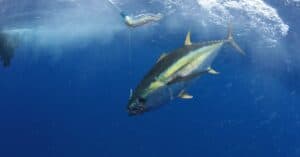
Tuna, a prized delicacy relished by seafood enthusiasts for generations, boasts a delectable taste and adaptable texture. It’s no wonder this fish has gained worldwide recognition as a favored seafood option. However, not all tuna share the same qualities.
These exclusive varieties are a true reflection of the finest that the ocean has to offer. Each has its unique flavor profile, texture, appearance, and price tag.
In this article, let’s unveil the most expensive types of tuna in 2024!
5. Albacore Tuna: $18 to $22 Per Pound
The South Pacific and Mediterranean waters, including the areas surrounding Fiji and Hawaii, are famous for the abundant fresh catch of albacore tuna. What sets them apart from other tuna varieties is their distinct fishy taste and a texture that easily flakes.
In terms of appearance, albacore tuna have sleek, torpedo-shaped bodies with smooth skin and streamlined fins. Their backs sport a dark blue color, while their bellies showcase a mix of dusky to silvery white shades. One striking feature is their notably long pectoral fins, which can span at least half the length of their bodies.
When it comes to growth, albacore tuna experience a rapid initial growth phase. However, their rate slows down as they mature. They can reach sizes of up to nearly 80 pounds and measure approximately 47 inches in length.
As top predators in the ocean, albacore tuna are capable hunters with a diverse diet. They mainly feed on marine creatures, such as mollusks, squids, crustaceans, and other fish species. To some extent, albacore tuna can be classified as omnivores since they occasionally consume plant-based foods like phytoplankton.
The highest-priced albacore tuna are whole fish weighing 80 pounds or more. And fresh (unfrozen) wild-caught albacore fetch significantly higher prices compared to canned alternatives. Albacore tuna is typically priced between $18 and $22 per pound.
Why Is Albacore Tuna Expensive?
Generally, compared to other types of tuna, albacore is not expensive at all. The reason behind this lies in the fact that it is predominantly used for producing canned tuna, which has a longer shelf life than fresh cuts of tuna. Consequently, the market supply for albacore tuna is typically higher, leading to more competitive pricing. However, it is essential to consider that unsustainable fishing practices may affect the availability of this tuna type and potentially increase costs in the future.
Another factor affecting tuna prices is the “sashimi-grade” or “sushi-grade” label, which shows the tuna’s quality and safety for eating raw. Nevertheless, it is relatively uncommon to encounter albacore tuna with these designations.
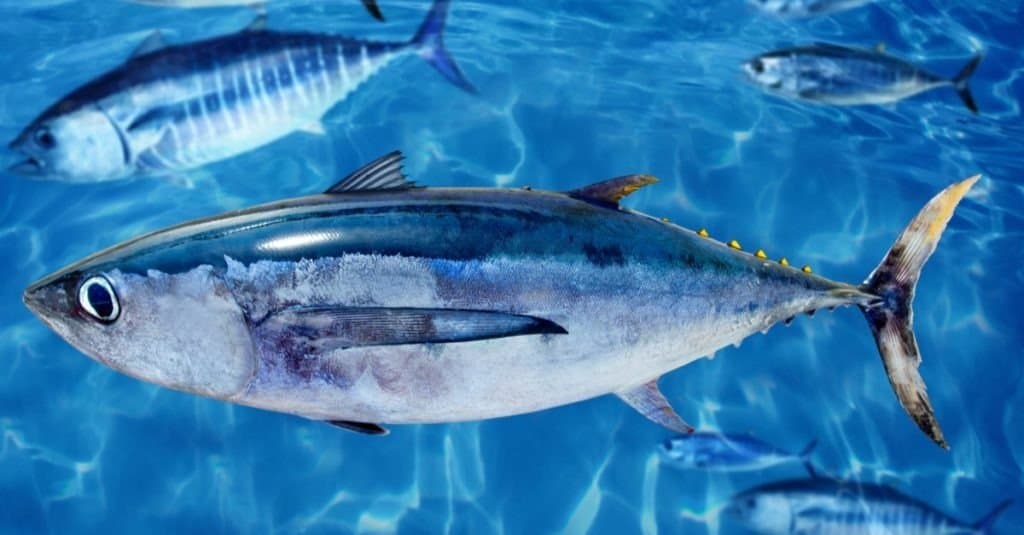
Albacore Tuna’s price ranges from $18 to $22 per pound.
©lunamarina/Shutterstock.com
4. Skipjack Tuna: $23 to $30 Per Pound
Skipjack tuna inhabit the warm waters of subtropical, tropical, and warm temperate regions across all the world’s oceans. They differ from other tuna species by their preference for surface-dwelling, which makes them more accessible to fishermen. Skipjack tuna has a distinct flavor, often described as “fishy.” If you come across a can of tuna labeled “chunk light,” it’s likely to contain skipjack tuna.
Among the commercially important tuna species, skipjack is the smallest and most abundant. It possesses a sleek body with minimal scales. It features dark purple-blue coloring on the back and silver hues on the lower sides and bellies, marked by four to six dark bands. Despite their petite size, these fish can still weigh around 70 pounds.
Skipjack tuna have a diverse diet that includes small fish, squids, pelagic crustaceans, and other tiny invertebrates. Unlike some other species, skipjack lacks the ability to suction feed. Instead, it relies on its impressive swimming speed to chase down and bite its prey.
Fresh fillets of skipjack tuna are considered the priciest option. Canned alternatives and frozen fillets tend to be more budget-friendly. Compared to other types of tuna, skipjack tuna catches attention for its reasonable cost, typically priced at around $23 to $30 per pound.
Why Is Skipjack Tuna Expensive?
When it comes to pricing, skipjack tuna falls just a little above albacore tuna, with the difference being almost insignificant. However, skipjack’s widespread availability as the most prevalent type of wild tuna helps keep its cost relatively affordable.
The slight increase in price can be attributed to Skipjack’s favorable reputation among consumers. While albacore is often associated with lower-cost tuna options, skipjack is considered a slightly more esteemed and desirable choice.
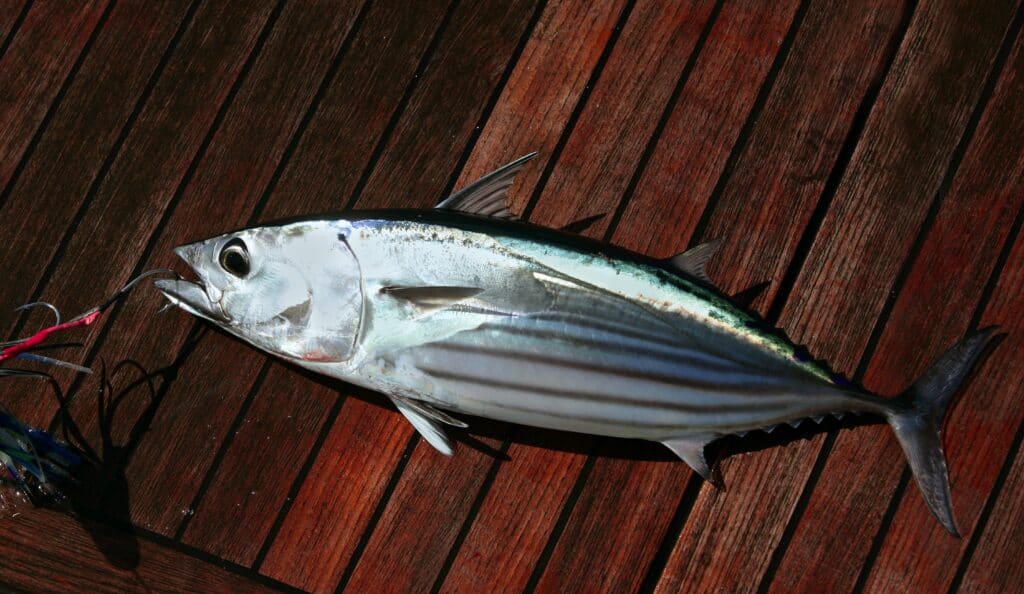
Skipjack Tuna’s price ranges from $23 to $30 per pound.
©iStock.com/LUNAMARINA
3. Yellowfin Tuna: $30 to $35 Per Pound
Yellowfin tuna, known as ahi tuna, inhabit tropical and subtropical oceans across different regions of the world. With impressive sizes of up to 6 feet in length and averaging 400 pounds in weight, they rank among the largest tuna species globally.
The flesh of yellowfin tuna is light pink and has a dry, firm texture with a noticeable fat. However, it is still leaner compared to the famous bluefin tuna. While its flavor retains the characteristic “tuna” taste, the yellowfin tuna is considered to be of lower quality than the meatier alternative. When purchasing yellowfin tuna for raw consumption, it is important to specifically look for “sashimi grade.” Any other types should not be consumed uncooked.
Yellowfin tuna possesses a torpedo-shaped body, showcasing metallic dark blue coloration on its back and upper sides, transitioning to yellow and silver shades on its belly. The distinct yellow hue appears on its dorsal and anal fins, as well as its finlets.
Feeding near the top of the food chain, yellowfin tuna primarily prey on fish, squid, and crustaceans. And on the flip side, they themselves become targets for apex predators like sharks and larger fish. However, thanks to their remarkable speed, reaching up to 47 miles per hour, yellowfins are capable of evading most predators.
Hawaiian wild-caught ahi tuna stands as one of the most expensive options available to consumers. Prices can reach up to $35 per pound or even higher. Fresh cuts obtained from recently caught fish are particularly sought after. However, enjoying such delicacies often requires a visit to the Hawaiian islands.
The freezing process, which is used to ship yellowfin tuna around the globe, can result in damage to the fish’s texture and flavor, significantly reducing its worth.
Why Is Yellowfin Tuna Expensive?
Renowned for its substantial size and widespread consumer demand for sushi, this particular fish stands among the pricier options. Yet, yellowfin tuna remains remarkably accessible in North America, making it a highly coveted selection for diners in the United States and Canada.

Yellowfin Tuna’s price ranges from $30 to $35 per pound.
©Al McGlashan/Shutterstock.com
2. Bigeye Tuna: $40 to $200 Per Pound
In the vast Atlantic Ocean, a species known as the bigeye tuna roams freely. Similar in size to its counterpart, the yellowfin tuna, the bigeye possesses physical characteristics that bear a striking resemblance. However, what truly sets it apart is the distinct flavor it brings to the table, owing to this tuna’s preference for colder waters.
Distinguished by its mild yet robust taste, the bigeye tuna boasts a higher fat content compared to the yellowfin. Sought after by sashimi connoisseurs, it presents a culinary delight like no other.
The back and upper sides of the bigeye shimmer in a mesmerizing metallic blue. Its lower sides and belly glisten in pristine white. The first dorsal fin adorns a deep yellow hue, accompanied by pale yellow tones in the second dorsal and anal fins. The finlets, vibrant with bright yellow hues and bordered by contrasting black edges, further increase its charm. Although resembling the yellowfin in many ways, the bigeye has the ability to grow to impressive lengths. They can grow up to a staggering 8 feet or even more in some cases!
As an apex predator, the bigeye tuna have a diverse diet, primarily consisting of various fish species, along with the occasional squid and crustaceans.
The bigeye tuna caught fresh in the untamed waters off the coast of New England are the best of the best. They’re highly sought after and carry a hefty price tag.
Interestingly, if you happen to be at the docks where the fishing boats unload their catches, you’ll find that the prices for bigeye tuna are surprisingly low. However, once these prized catches make their way to fish markets, especially those located far from the coastal areas, be prepared to pay anywhere between $40 to $200 per pound.
Why Is Bigeye Tuna Expensive?
Bigeye tuna comes with a hefty price tag, and you might wonder why. It all boils down to one thing: its incredible demand among sushi and sashimi lovers. This fatty fish is a true delicacy, especially when it comes to its toro cuts. These cuts, sourced from the belly, are the most succulent and prized parts of the fish.
But that’s not all. Bigeye tuna also offers a fantastic alternative for those seeking something better than low-quality albacore or the expensive bluefin tuna.
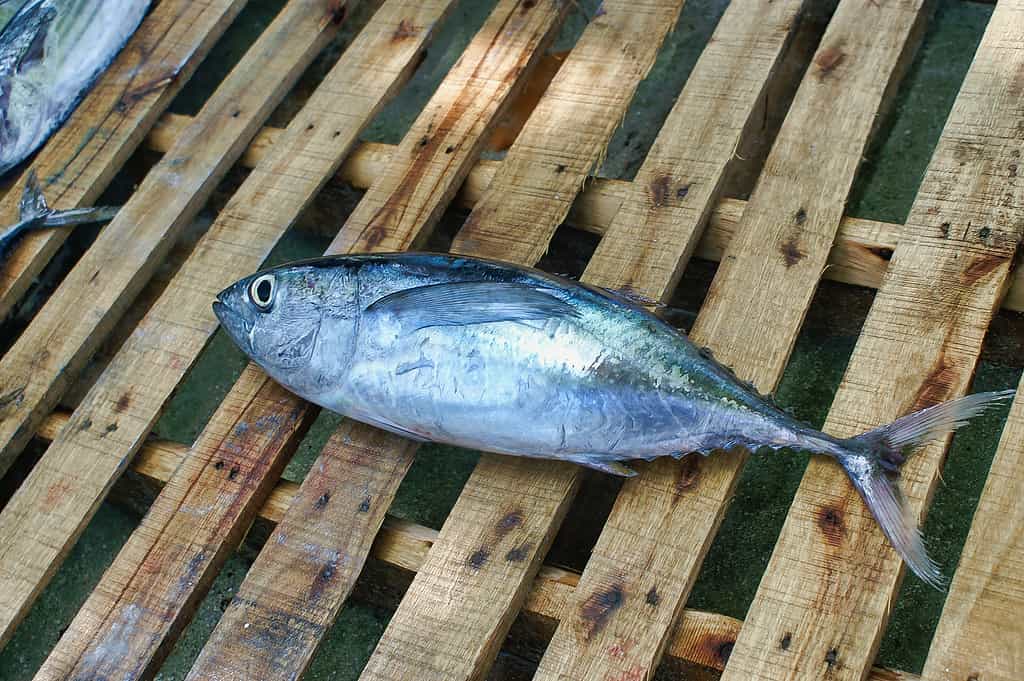
Bigeye Tuna’s price ranges from $40 to $200 per pound.
©MikeCloudStock/Shutterstock.com
1. Bluefin Tuna: $20 to $5,000 Per Pound
Bluefin tuna, the Rolls Royce of the tuna family, is commonly found in the Pacific, Indian, and Atlantic Oceans. It thrives in depths ranging from 1,600 to 3,200 feet, necessitating advanced commercial fishing gear.
What makes bluefin tuna highly sought after is their exquisite flavor and delicate marbling, setting them apart from other species. Sadly, overfishing has severely impacted wild bluefin populations, particularly in the Atlantic, where they face the greatest risk.
With their impressive, torpedo-shaped bodies resembling near-perfect circles, bluefin tuna reign as the largest among their tuna counterparts. They can reach lengths of up to 13 feet and weigh a staggering 2,000 pounds. Sporting a dark blue-black hue on their dorsal side and a contrasting white shade on their underbelly, these majestic creatures are a captivating sight.
While juveniles primarily dine on squid, crustaceans, and fish, adult bluefins predominantly feed on baitfish like bluefish, mackerel, and herring.
Due to the decline in wild bluefin populations, the availability of this coveted fish has decreased, leading to a significant rise in prices. A pound of wild-caught bluefin tuna can now range anywhere from $20 to $5,000, reflecting the scarcity of this delicacy.
When it comes to whole, freshly caught bluefin tuna, their cost tends to be higher than individual cuts. Notably, an exceptional-quality bluefin tuna weighing over 600 pounds can yield hundreds of mouthwatering sashimi portions or dozens of premium fillets.
Why Is Bluefin Tuna Expensive?
Bluefin tuna holds the crown as the priciest among its tuna counterparts, particularly those caught in the waters surrounding Japan, where they are auctioned off to local markets and prestigious sushi restaurants directly from the docks.
In 2019, a Japanese sushi tycoon named Kiyoshi Kimura made headlines by shelling out a staggering $3.1 million for a colossal bluefin tuna weighing 612 pounds. This extravagant purchase cemented its status as the world’s most expensive tuna.
This sought-after tuna is served fresh, highlighting its delicate flavor and melt-in-your-mouth texture rather than being confined to cans. Its staggering cost is attributed to high demand, its remarkable size (averaging 500 pounds but reaching over 600 pounds), and its association with creating exclusive sushi dishes.

Bluefin tuna’s price ranges from $20 to $5,000 per pound.
©iStock.com/LUNAMARINA
Summary of the Top 5 Most Expensive Types of Tuna in 2023
| Rank | Tuna Type | Price |
|---|---|---|
| 1 | Bluefin | $20 to $5,000 Per Pound |
| 2 | Bigeye | $40 to $200 Per Pound |
| 3 | Yellowfin | $30 to $35 Per Pound |
| 4 | Skipjack | $23 to $30 Per Pound |
| 5 | Albacore | $18 to $22 Per Pound |
What is the Most Expensive Part of the Tuna?
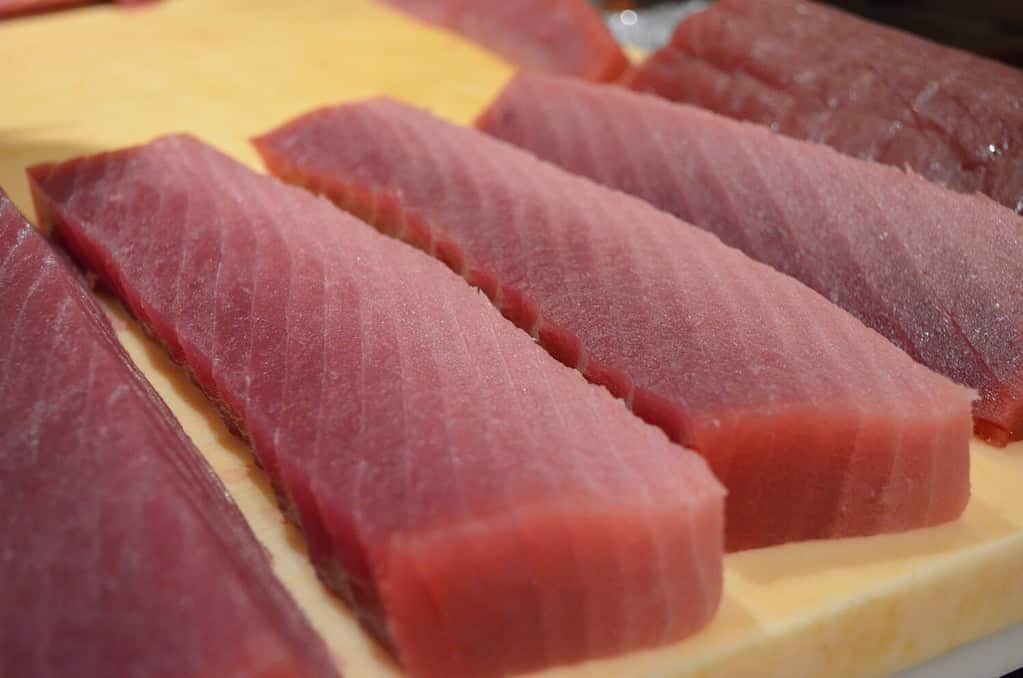
Maguro is the Japanese word for bluefin tuna which is broken down into three distinct parts. The underbelly, and most desirable parts, are known as Toro and Otoro.
©AIVRAD/Shutterstock.com
The most desirable, and most expensive, part of a tuna is the underbelly, also known as Otoro. This section is also the fattiest of the tuna and differs from the rest of it, not only in taste but in name. The Japanese word for bluefin tuna is Maguro, but it is broken down into three different parts that each have their own distinct flavor. There is the Akami, which is the red meat, and then two different areas of the desirable underbelly – the medium-fatty part, called Chūtoro or Toro, and the fattiest part, called Otoro.
The bluefin tuna is the species that commands a higher price and the Otoro is one of the most sought-after pieces due to its melt-in-your-mouth buttery and rich texture. The Otoro and Toro cuts are known as toro grade and they can only be obtained from the bluefin. Toro can be found commonly in sushi restaurants, but Otoro is rather rare.
The photo featured at the top of this post is © funny face/Shutterstock.com
Thank you for reading! Have some feedback for us? Contact the AZ Animals editorial team.





